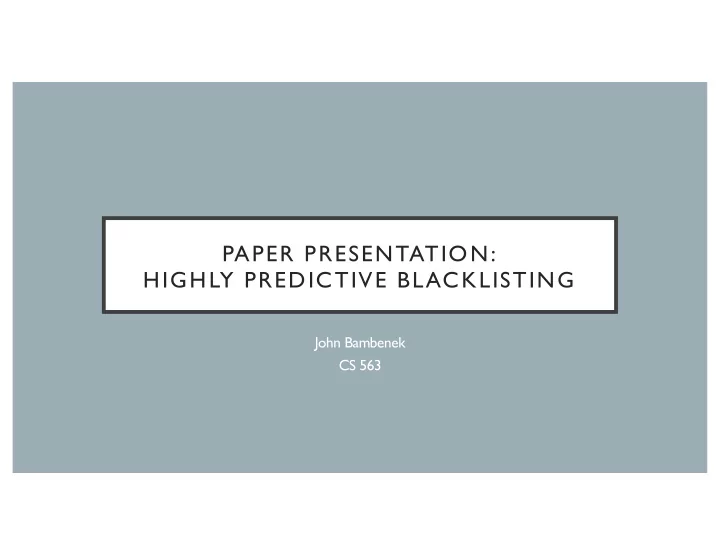

PAPER PRESENTATION: HIGHLY PREDICTIVE BLACKLISTING John Bambenek CS 563
PROBLEM • There are “tons” of malicious events detected by firewalls, intrusion detection systems, web application firewalls, etc. • The adversarial infrastructure may be persistent, may be a VPS, compromised host, etc. • Can I determine both what is most relevant to my organization and relevant globally that will be worth blocking “in the future”?
PROBLEM • Consider your typical firewall: • iptables –A INPUT –p 80 –j ACCEPT • What does this not protect against?
WHAT IS DSHIELD? • Run by SANS (I’m one of the Handlers) where people submit firewall and IDS block logs from around the world. • Also can operate a DShield sensor as a raspberry pi. Primarily finds port-level blocks and darknet traffic. • Each user has their own ID, can also “action” blocks. In turn, this gives a huge dataset that is ”mostly” globally representative about “loud attacks”.
THREE APPROACHES • Global Worst Offender Lists (GWOL) • Misses targeted or localized attacks • Local Worst Offender Lists (LWOL) • Misses attacks that may not have “gotten there” yet • This paper introduces Highly-Predictive Blacklist (HPB) that uses elements of both.
HPB APPROACH • Analogous to Google PageRank • Incorporates the following: • Log prefiltering (i.e. RFC 1918 addresses, “local” addresses, etc • Relevance based ranking (per-contributor basis) • Severity analysis (looks at known malware propagation patterns)
ARCHITECTURE
PRE-FILTERING • Drop the obvious noise: • RFC 1918 addresses • Bogons • Unassigned IPs • Why? • Drop “internet measurement” services, crawlers, etc. W hy? • Drop common ports (80, 53, 25, 443)
RELEVANCE RANKING • How “close” is a specific attacker to a specific victim? • If you have enough data about many victims, you can see patterns and order of how attacks progress through internet. (i.e. Attacker X will always hit Victim A 2 days before Victim B.)
RELEVANCE RANKING • Create a matrix based on (m ij / m i ) (common attack sources / all attack sources) for each relationship between victims and sources. (First pass) • R s = W x b s (Relvancy vector is product of Adjacency matrix and attack vector)
RELEVANCE WITH “LOOK AHEAD”
PROPAGATING RELEVANCY • Better version is: • Solving for x: • This gives something used by PageRank to figure relevant results.
ATTACK SEVERITY • Note: This paper was done in 2008. This is important. • Malicious behavior modeled after typical “scan-and-infect” behavior. • Calculates based on /24 network basis. • Three factors used: Port Score, Target Count, International Victim Count
LIST PRODUCTION • Then just sort by score and pick X to generate the list. • All protective technologies (firewalls, routers, etc) have limits in how many entries they can accept. • Results showed a 20-30% increase.
RISKS • Can a false positive entry be included? • There is a global white-list but not a localized one (and more importantly, there is no “good” global whitelist. (Some of my upcoming research). • Can an attacker get their attacks excluded? • Can be a sensor and try to break various elements of alignment but requires broad (but not complete) knowledge of the ecosystem and relationships. • Can all the data be poisoned? • It’s a volunteer system, so anyone can join and dump in junk data
CURRENT STATE (Not in paper) • SRI has ”abandoned” the code. • DShield no longer generates HBPLs. • *Incoming* attack data is not as important as *outgoing* attack data. • Malware beacons out now, reverse shells are common. Best way to beat a firewall is to have a machine on inside using existing ACLs.
QUESTIONS?
Recommend
More recommend